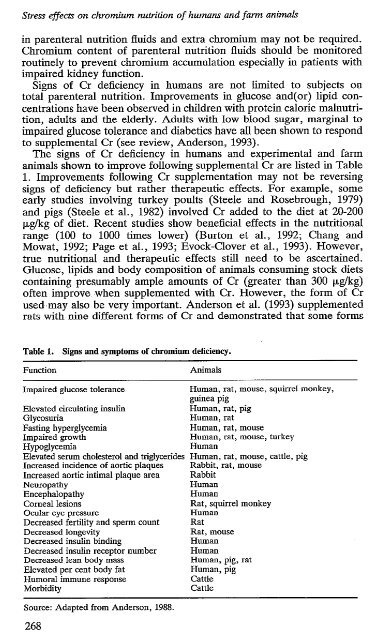Stress Effects on Chromium Nutrition of Humans and Farm Animals
Stress Effects on Chromium Nutrition of Humans and Farm Animals
Stress Effects on Chromium Nutrition of Humans and Farm Animals
Create successful ePaper yourself
Turn your PDF publications into a flip-book with our unique Google optimized e-Paper software.
<str<strong>on</strong>g>Stress</str<strong>on</strong>g> effects <strong>on</strong> chromium nutriti<strong>on</strong> <strong>of</strong> humans aad farm animals<br />
in parenteral nutriti<strong>on</strong> fluids <strong>and</strong> extra chromium may not be required.<br />
<strong>Chromium</strong> c<strong>on</strong>tent <strong>of</strong> parenteral nutriti<strong>on</strong> fluids should be m<strong>on</strong>itored<br />
routinely to prevent chromium accumulati<strong>on</strong> especially in patients with<br />
impaired kidney functi<strong>on</strong>.<br />
Signs <strong>of</strong> Cr deficiency in humans are not limited to subjects <strong>on</strong><br />
total parenteral nutriti<strong>on</strong>. Improvements in glucose <strong>and</strong>(or) lipid c<strong>on</strong>-<br />
centrati<strong>on</strong>s have been observed in children with protein calorie malnutri-<br />
ti<strong>on</strong>, adults <strong>and</strong> the elderly. Adults with low blood sugar, marginal to<br />
impaired glucose tolerance <strong>and</strong> diabetics have all been shown to resp<strong>on</strong>d<br />
to supplemental Cr (see review, Anders<strong>on</strong>, 1993).<br />
The signs <strong>of</strong> Cr deficiency in humans <strong>and</strong> experimental <strong>and</strong> farm<br />
animals shown to improve following supplemental Cr are listed in Table<br />
1. Improvements following Cr supplementati<strong>on</strong> may not be reversing<br />
signs <strong>of</strong> deficiency but rather therapeutic effects. For example, some<br />
early studies involving turkey poults (Steele <strong>and</strong> Rosebrough, 1979)<br />
<strong>and</strong> pigs (Steele et al., 1982) involved Cr added to the diet at 20-200<br />
pg/kg <strong>of</strong> diet. Recent studies show beneficial effects in the nutriti<strong>on</strong>al<br />
range (100 to 1000 times lower) (Burt<strong>on</strong> et al., 1992; Chang <strong>and</strong><br />
Mowat, 1992; Page et al., 1993; Evock-Clover et al., 1993). However,<br />
true nutriti<strong>on</strong>al <strong>and</strong> therapeutic effects still need to be ascertained.<br />
Glucose, lipids <strong>and</strong> body compositi<strong>on</strong> <strong>of</strong> animals c<strong>on</strong>suming stock diets<br />
c<strong>on</strong>taining presumably ample amounts <strong>of</strong> Cr (greater than 300 &kg)<br />
<strong>of</strong>ten improve when supplemented with Cr. However, the form <strong>of</strong> Cr<br />
used,may also be very important. Anders<strong>on</strong> et al. (1993) supplemented<br />
rats with nine different forms <strong>of</strong> Cr <strong>and</strong> dem<strong>on</strong>strated that some forms<br />
TabIe 1. Signs <strong>and</strong> symptoms <strong>of</strong> chromium deficiency.<br />
Functi<strong>on</strong> <strong>Animals</strong><br />
Impaired glucose tolerance<br />
Human, rat, mouse, squirre1 m<strong>on</strong>key,<br />
guinea pig<br />
Elevated circulating insulin Human, rat, pig<br />
Glycosuria Human, rat<br />
Fasting hyperglycemia Human, rat, mouse<br />
Impaired growth Human, rat, mouse, turkey<br />
Hypoglycemia Human<br />
Elevated serum cholesterol <strong>and</strong> triglycerides Human, rat, mouse, cattle, pig<br />
Increased incidence <strong>of</strong> aortic plaques Rabbit, rat, mouse<br />
Increased aortic intimal plaque area Rabbit<br />
Neuropathy Human<br />
EncephaIopathy Human<br />
Cornea1 Iesi<strong>on</strong>s Rat, squirrel m<strong>on</strong>key<br />
Ocular eye pressure Human<br />
Decreased fertility <strong>and</strong> sperm count Rat<br />
Decreased l<strong>on</strong>gevity Rat, mouse<br />
Decreased insulin binding Human<br />
Decreased insulin receptor number HUmaIl<br />
Decreased Iean body mass Human, pig, rat<br />
Elevated per cent body fat Human, pig<br />
HumoraI immune resp<strong>on</strong>se Cattle<br />
Morbidity Cattle<br />
Source: Adapted from Anders<strong>on</strong>, 1988.<br />
268


